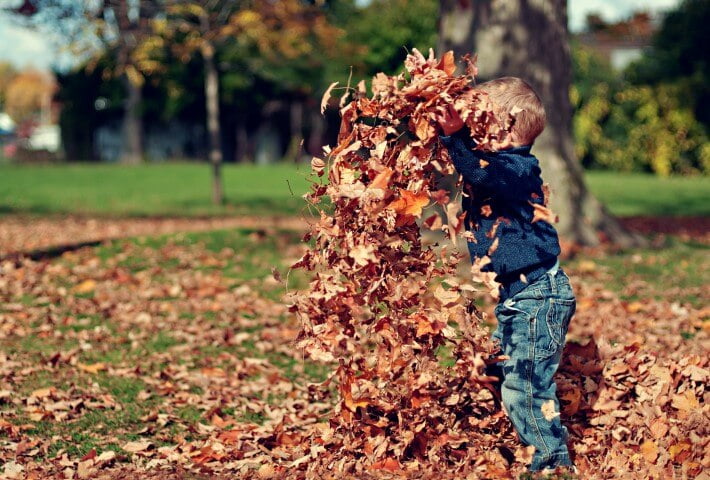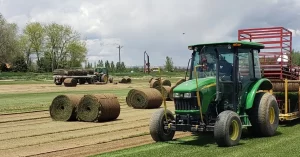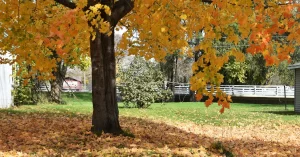
Autumn Lawn Care Guide
The fall season is upon us and winter is quickly approaching!
Start Preparing Your Lawn for Winter
Autumn, with its cooler temperatures and occasional rainfall, is the ideal time to prepare your lawn for next spring.
Many homeowners think lawns need less care in the fall because the grass grows more slowly. In fact, just the opposite is true. During this time of year, grass is busily absorbing energy, moisture, and nutrients in preparation for a long, dormant winter.
Give it a little attention now, and you’ll be rewarded with a lush, healthy spring lawn.
Keep Watering Your Lawn
With cooler temperatures you won’t need to water as much, but you still need to water–2-3 times per week (.5” to 1”) depending upon weather conditions. Water in the morning around 6:00 am. If you have blown out your irrigation system and the weather is mild and dry, use a hose and sprinkler.
Continue to Mow Your Lawn
Mow as needed, throughout the fall. As the season draws to a close, gradually drop the mower’s blade to its lowest setting for the last two cuttings of the year. As you lower the blade, remember not to trim off more than one-third of the grass blades at any one time. Shortening the cutting height will allow more sunlight to reach the crown of the grass. There will be less leaf to turn brown during the winter and less leaf to be matted down by snow.
Raking Leaves Weekly
It’s no one’s idea of fun, but it’s important to remove fallen leaves from your lawn as soon as possible. Don’t wait until all the leaves have fallen from the trees to start raking. Fallen leaves become wet from rain and morning dew, stick together, and form an impenetrable mat that can suffocate the grass and breed fungal diseases. An alternative to raking leaves is to use a lawnmower fitted with a collection bag or vacuum system.
Aerate the Soil
Fall is also an ideal time to aerate your lawn so that oxygen, water, and fertilizer can easily reach the grass’ roots. You can rent a gas-powered, walk-behind lawn aerator. The self-propelled machine will quickly punch holes into the soil and extract plugs of dirt. You can also simply hire a landscaping contractor.
Fall fertilization is the Most Important
Fall fertilization for future grass health, especially if you only fertilize once per year. Grass leaves grow much more slowly as the weather turns cool, but the grass roots and rhizomes continue to grow quickly. (Rhizomes are the horizontal plant stems that lie just beneath the soil’s surface; they produce the blades of grass above and the roots below.) A fall application delivers essential nutrients for the grass to grow deep roots and to keep nutrients on reserve for a healthy start next spring. Wait until mid-to-late fall, then apply a lawn WINTER fertilizer, which is specially formulated to be higher in potassium than regular lawn food. Potassium is the nutrient that makes grasses more winter hardy.
Time to control Weeds (Again!)
If broadleaf weeds like dandelions have taken over your lawn, now’s the time to fight back. Weeds, like most plants, are in the energy-absorbing mode during the fall. They’re drinking in everything that comes their way, including weed killers. Apply an herbicide now and the weeds won’t return in the spring. Read the package label before use. Most herbicide manufacturers recommend applying the weed killer during early-to-mid autumn, when daytime temperatures are consistently above 60 degrees Fahrenheit.
Overseeding
Autumn is a great time of year to overseed any bare, bald spots in your lawn. You can use plain seed or a repair mix that incorporates mulch. Make sure you buy the correct seed variety as your current lawn. Grasses are not all the same!!
The first step is to rake out some of the dead in the area. You don’t have to remove it completely. “Fan” a very thin layer of soil/compost mix over the area. Next, spread the seed lightly without overcrowding. Finally, lightly drag the seed into the soil with the back of your hand or the back of a rake. This will insure that the seed is in full contact with the ground, but not buried. Water every other day the seed bed moist while the seed grows.
CSU Lawncheck
Colorado State University provides an inexpensive, on-site lawn consultation service conducted by CSU horticultural specialists who will come to your home and make recommendations for improving your lawn and solving insect, disease and other lawn problems. For more information:
http://lawncheck.colostate.edu
CSU Lawncheck is currently available from Colorado State University Extension offices in
the following counties:
- Adams – (303)-637-8100
- Arapahoe – (303) 730-1920
- Boulder – (303) 678-6238
- Denver/Jefferson – (303) 271-6620
- Larimer – (970) 498-6000
A great resource, by phone or email If you have lawn questions, and there’s no charge. Your message should include a short, detailed description of the problem and its location in the landscape.
Leave a Replay

Recent Posts
Follow Us
Categories
Sign up for our Newsletter
Click edit button to change this text. Lorem ipsum dolor sit amet, consectetur adipiscing elit


